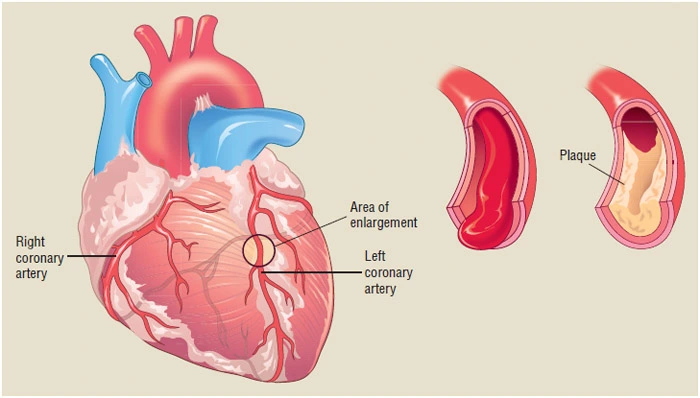3 types of Coronary artery Disease
Understanding the Three Types of Coronary Artery Disease: Unraveling the Hidden Threats to Heart Health: Coronary artery disease (CAD) is a prevalent and serious cardiovascular condition that affects millions of people worldwide. It occurs when the coronary arteries, responsible for supplying blood to the heart muscle, become narrowed or blocked by a buildup of plaque. This leads to reduced blood flow and oxygen supply to the heart, resulting in various heart-related complications. Understanding the different types of CAD is crucial for early detection, accurate diagnosis, and effective management. In this comprehensive guide, we will explore the three main types of coronary artery disease, their characteristics, causes, symptoms, diagnostic methods, and treatment options.3 types of Coronary artery Disease will completely explain.

Type 1 Coronary Artery Disease: “3 types of Coronary artery Disease”
Type 1 CAD, also known as atherosclerotic coronary artery disease, is the most common form of the condition. It is characterized by the development of atherosclerotic plaques within the coronary arteries. These plaques are made up of cholesterol, fat, calcium, and other substances, which gradually build up on the arterial walls, causing them to narrow and stiffen.
Read Also: Exploring the Landscape of Human Health Issues and Solution in 5+Way
Causes and Risk Factors:(3 types of Coronary artery Disease)
The primary cause of Type 1 CAD is atherosclerosis, a chronic inflammatory process triggered by various risk factors such as:
- High blood pressure
- High cholesterol levels
- Smoking
- Diabetes
- Obesity
- Sedentary lifestyle
- Family history of CAD
- Age and gender (men are at a higher risk than premenopausal women)
Symptoms and Clinical Presentation: The symptoms of Type 1 CAD can vary from mild to severe and may include:
- Chest pain or angina
- Shortness of breath
- Fatigue
- Heart palpitations
- Sweating
- Nausea
Diagnostic Methods:
To diagnose Type 1 CAD, doctors may use a combination of the following tests:
- Electrocardiogram (ECG/EKG)
- Stress tests
- Coronary angiography
- Cardiac CT scan
- Cardiac MRI
Treatment Options and Management Strategies:
Treatment for Type 1 CAD focuses on managing risk factors and improving blood flow to the heart. This may involve lifestyle changes, medications, and, in severe cases, interventions like angioplasty and stent placement or coronary artery bypass grafting (CABG).These 3 types of Coronary artery Disease can be very harmful also.
Read Also: How Can I Grow My Chest Bigger and Achieve Impressive Results?:Unveiling the Secrets in 2023
Type 2 Coronary Artery Disease: “3 types of Coronary artery Disease”
Type 2 CAD is a unique and less understood form of coronary artery disease. It occurs when there is an imbalance between oxygen demand and supply to the heart, often unrelated to atherosclerosis.
Causes and Associations:(3 types of Coronary artery Disease)
Type 2 CAD can be triggered by various factors, including:
- Severe anemia
- Thyroid disorders
- Infection or inflammation
- Drug use (e.g., cocaine)
- Excessive emotional stress
- Blood pressure fluctuations
- Coronary artery spasm (vasospastic angina)
Role of Risk Factors and Comorbidities:
While Type 2 CAD can occur in individuals with or without traditional risk factors, its incidence may be higher in those with pre-existing conditions like diabetes, obesity, or hypertension.
Symptoms and Clinical Manifestations:
The symptoms of Type 2 CAD may not always fit the classic angina pattern, making diagnosis challenging. Symptoms can include:
- Atypical chest pain
- Unexplained fatigue
- Shortness of breath
- Irregular heartbeats
Diagnostic Approaches and Challenges:
Diagnosing Type 2 CAD often requires ruling out other potential causes of heart-related symptoms. Physicians may use various tests like stress imaging, Holter monitoring, and coronary angiography to reach a definitive diagnosis.
Treatment and Preventive Measures:
The management of Type 2 CAD involves addressing underlying causes, managing risk factors, and improving heart function. Medications, lifestyle changes, and stress management techniques play a crucial role in the treatment approach.
Read Also: Stress Balls: The Secret Weapon for Instant Relaxation in 2023
Type 3 Coronary Artery Disease: “3 types of Coronary artery Disease”
Type 3 CAD is a less common form of coronary artery disease characterized by sudden coronary artery dissection, spasm, or embolism.
Definition and Significance:
Type 3 CAD presents unique challenges in diagnosis and management due to its acute nature. It can lead to life-threatening situations, such as myocardial infarction (heart attack) or cardiac arrest.
Differentiating Features from Other Types:
Type 3 CAD stands apart from Type 1 and Type 2 in 3 types of Coronary artery Disease CAD as it involves sudden mechanical changes in the coronary arteries rather than gradual atherosclerosis.
Etiology and Triggers:
The precise causes of Type 3 CAD are not always clear, but potential triggers include:
- Hormonal changes (e.g., pregnancy, postpartum)
- Connective tissue disorders
- Trauma to the chest
- Cocaine use
- Spontaneous arterial dissection
Atypical Symptoms and Variations in Presentation:
The symptoms of Type 3 CAD may differ from typical angina, and patients might experience:
- Unpredictable chest pain
- Recurrent palpitations
- Sweating and dizziness
Diagnostic Considerations and Specialized Tests:
Diagnosing Type 3 CAD often requires urgent evaluation, which may involve coronary angiography, intravascular imaging, and optical coherence tomography (OCT).
Therapeutic Interventions and Long-Term Management:
Immediate medical attention is crucial for Type 3 CAD, with treatment aimed at relieving artery dissection or spasms. Long-term management involves addressing risk factors and lifestyle modifications to prevent recurrence.
Comparative Analysis:
In this section, we will compare the 3 types of Coronary artery Disease, highlighting their differences, similarities, and unique aspects. We will discuss the impact of each type on patient prognosis, the challenges in diagnosis and management, and the latest research and advancements in understanding CAD types.
Read Also: Can We Train Forearms Daily Benefits and Risks:Unlocking Untapped Power in 2023
Conclusion:(3 types of Coronary artery Disease)
In conclusion, coronary artery disease is a complex condition with various types, each requiring a distinct approach to diagnosis and management. Recognizing the differences between Type 1, Type 2, and Type 3 CAD is crucial for providing targeted and effective care to patients. Early detection, lifestyle modifications, and adherence to medical advice can significantly improve outcomes and enhance the quality of life for those affected by coronary artery disease.
As new research and medical advancements continue to emerge, our understanding of these CAD types will evolve, leading to better preventive measures and more innovative treatment options for this widespread cardiovascular disease.





